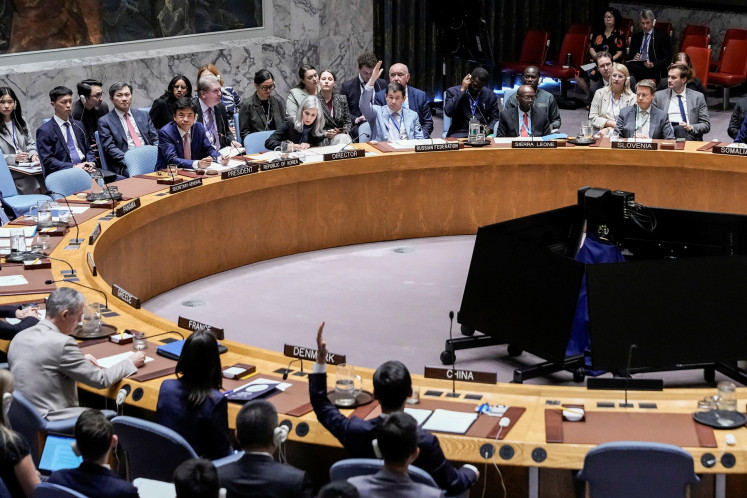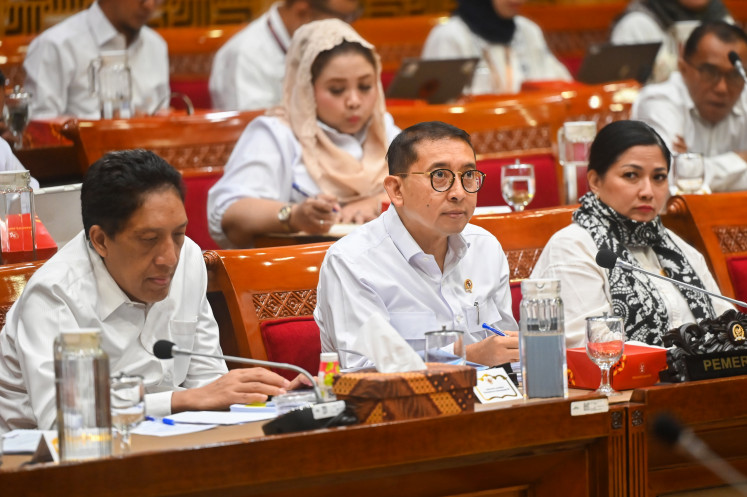Popular Reads
Top Results
Can't find what you're looking for?
View all search resultsPopular Reads
Top Results
Can't find what you're looking for?
View all search resultsJapan, China compete for East Asia
The Jakarta Post’s Riyadi Suparno and four other journalists from Malaysia, the Philippines, Singapore, and Thailand visited Japan late October, on the invitation of the Tokyo-based Keizai Koho Center
Change text size
Gift Premium Articles
to Anyone
T
he Jakarta Post’s Riyadi Suparno and four other journalists from Malaysia, the Philippines, Singapore, and Thailand visited Japan late October, on the invitation of the Tokyo-based Keizai Koho Center. During the one-week visit, the journalists met with politicians, corporate executives and experts in various fields as well as visiting a number of corporate projects. What follows is Riyadi’s report from the trip.
Japan and China may be competing for the leadership of East Asia, but both countries, together with the Association of Southeast Asian Nations (ASEAN), are leading their way toward an East Asian Community, with greater prosperity and security.
While Japan is struggling with its so-called “70 percent economy”, i.e. an economy running at 70 percent of its capacity, China continues to book high economic growth and marches ahead faster, getting closer to overtaking Japan to become the world’s number two economy after the United States.
China’s leadership is even more evident in the loose-grouping of ASEAN+3 countries (10 Southeast Asian countries, plus China, Japan and South Korea).
Weary of China’s dominant role at ASEAN+3, Japan managed to help expand the grouping into ASEAN+6, with the addition of India, Australia and New Zealand, forming a grouping to counter-balance the influence of China.
“The development of ASEAN+3 into ASEAN+6 dilutes the influence of China, and is in accordance with Japan’s wish to balance China with more democratic states,” Go Ito, professor of international relation at Meiji University, told visiting ASEAN journalists in Tokyo.
ASEAN countries are unique in the framework of rivalry between Japan and China, as ASEAN tries to balance both China and Japan, including through free trade arrangements with each of them.
Japan may also be bearing in mind that the balance of economic power is changing fast within ASEAN, and between ASEAN, the region and the world. The Indonesian economy is predicted to overtake South Korea by 2016, Japan by 2024, the UK by 2031 and Germany by 2040, in a recent report from Standard Chartered Bank. So Japan has to adjust its position.
Shujiro Urata, professor of Asia-Pacific Studies at Waseda University, said that the free trade arrangements which ASEAN has with Japan and China would strengthen and boost further intra-regional trade.
Already, intra-regional trade involving ASEAN+3 countries had expanded rapidly from US$35.5 billion in 1980 to $52.3 billion in 2007.
The rate of increase in intra-regional trade in East Asia is even bigger than intra-regional trades in the European Union and North American Free Trade Agreement.
According to Urata, intra-regional trade in East Asia follows what he calls a triangular trade pattern, with China as the factory of the world, other East Asian countries as the supplier of parts and components for China and the rest of the world as the market.
This triangular trade patterns ensures that intra-regional trade would continue to blossom in this region, and increasing intra-regional trade will drive more and more regional economic integration.
An integrated more prosperous and stable East Asia would mean a lesser influence and roles for the United States in the region. The US presence in the region, including its military presence, would gradually be reduced.
Currently, the new Japanese government, for example, is thinking of merging the US Marine and Air Force bases into one – a move that apparently angers the US. People in South Korea have also made
calls for a reduced US military presence there.
“China has contributed significantly to the current stability in East Asia,” Professor Ito said. “But too much stability in Asia is a problem for the US. What’s good for the US is something like appropriately stable and appropriately unstable Asia,” he added.
Economically, according to Atsushi Saito, president and CEO of the Tokyo Stock Exchange Group, the United States would eventually lose to Asia, and therefore, Asia would become less and less dependent on the US.
Saito argued that Asia, unlike four or five decades ago, has much more production power than the US. And more importantly, Asia has growing demand and this demand would continue to propel growth
in Asia.
“If you look at history, how you enjoyed high growth in GDP was first when you had large agricultural [development, so that] people could be transferred to industry, and in the process, you enjoyed growth,” Saito told ASEAN journalists in a special interview.
In the case of China, for example, currently it has 700 million people working in the agriculture sector and only between 100 million and 200 million in the industrial sector. So, China still has a lost of room for higher growth, without so much dependence on the outside world.
“In contrast with the US, Asia, especially countries like China, India and Indonesia will continue to enjoy growth,” Saito said. “So, US will lose its position; definitely Asia will take over.”










